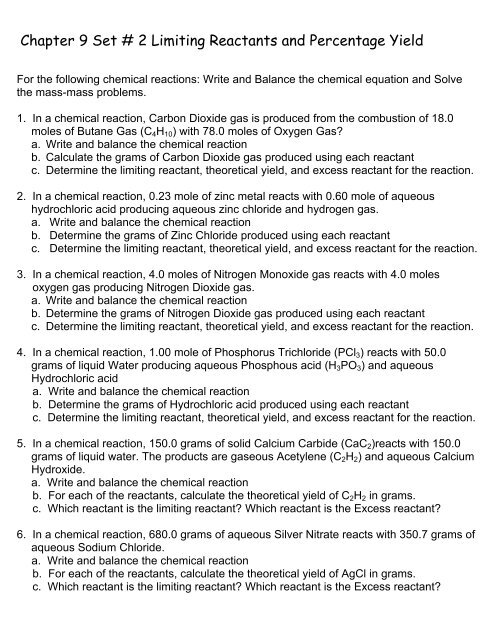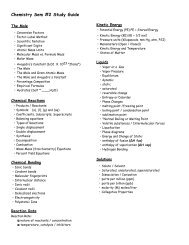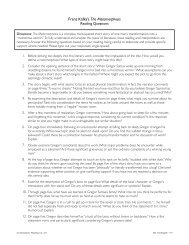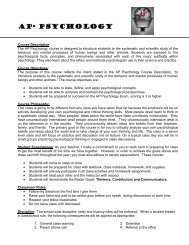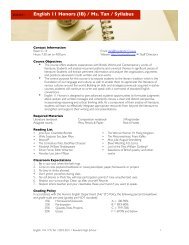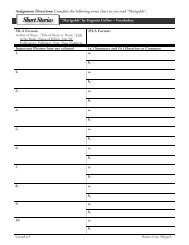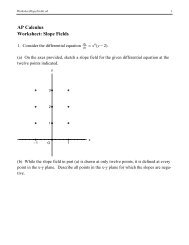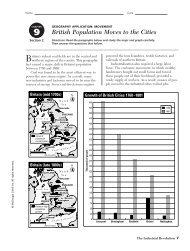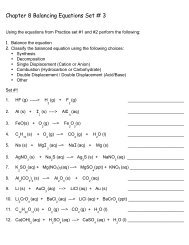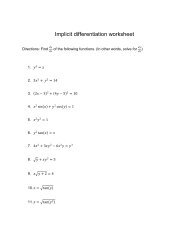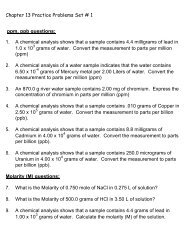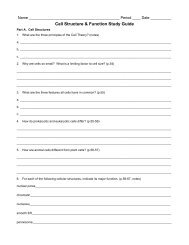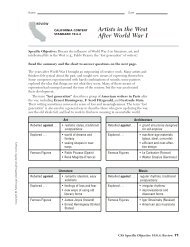Chapter 9 Mass-mass set _2 vs2
Chapter 9 Mass-mass set _2 vs2
Chapter 9 Mass-mass set _2 vs2
Create successful ePaper yourself
Turn your PDF publications into a flip-book with our unique Google optimized e-Paper software.
<strong>Chapter</strong> 9 Set # 2 Limiting Reactants and Percentage YieldFor the following chemical reactions: Write and Balance the chemical equation and Solvethe <strong>mass</strong>-<strong>mass</strong> problems.1. In a chemical reaction, Carbon Dioxide gas is produced from the combustion of 18.0moles of Butane Gas (C 4 H 10 ) with 78.0 moles of Oxygen Gas?a. Write and balance the chemical reactionb. Calculate the grams of Carbon Dioxide gas produced using each reactantc. Determine the limiting reactant, theoretical yield, and excess reactant for the reaction.2. In a chemical reaction, 0.23 mole of zinc metal reacts with 0.60 mole of aqueoushydrochloric acid producing aqueous zinc chloride and hydrogen gas.a. Write and balance the chemical reactionb. Determine the grams of Zinc Chloride produced using each reactantc. Determine the limiting reactant, theoretical yield, and excess reactant for the reaction.3. In a chemical reaction, 4.0 moles of Nitrogen Monoxide gas reacts with 4.0 molesoxygen gas producing Nitrogen Dioxide gas.a. Write and balance the chemical reactionb. Determine the grams of Nitrogen Dioxide gas produced using each reactantc. Determine the limiting reactant, theoretical yield, and excess reactant for the reaction.4. In a chemical reaction, 1.00 mole of Phosphorus Trichloride (PCl 3 ) reacts with 50.0grams of liquid Water producing aqueous Phosphous acid (H 3 PO 3 ) and aqueousHydrochloric acida. Write and balance the chemical reactionb. Determine the grams of Hydrochloric acid produced using each reactantc. Determine the limiting reactant, theoretical yield, and excess reactant for the reaction.5. In a chemical reaction, 150.0 grams of solid Calcium Carbide (CaC 2 )reacts with 150.0grams of liquid water. The products are gaseous Acetylene (C 2 H 2 ) and aqueous CalciumHydroxide.a. Write and balance the chemical reactionb. For each of the reactants, calculate the theoretical yield of C 2 H 2 in grams.c. Which reactant is the limiting reactant? Which reactant is the Excess reactant?6. In a chemical reaction, 680.0 grams of aqueous Silver Nitrate reacts with 350.7 grams ofaqueous Sodium Chloride.a. Write and balance the chemical reactionb. For each of the reactants, calculate the theoretical yield of AgCl in grams.c. Which reactant is the limiting reactant? Which reactant is the Excess reactant?
<strong>Chapter</strong> 9 Set # 2 Limiting Reactants and Percentage Yield7. Use the Theoretical Yield from practice problem #1 to determine the Percent Yield.Actual Yield = 1545 grams CO 28. Use the Theoretical Yield from practice problem #2 to determine the Percent Yield.Actual Yield = 24 grams ZnCl 29. Use the Theoretical Yield from practice problem #3 to determine the Percent Yield.Actual Yield = 150.5 grams NO 210. Use the Theoretical Yield from practice problem #4 to determine the Percent Yield.Actual Yield = 81.0 grams HCl11. Use the Theoretical Yield from practice problem #5 to determine the Percent Yield.Actual Yield = 38.50 grams C 2 H 212. Use the Theoretical Yield from practice problem #6 to determine the Percent Yield.Actual Yield = 372.6 grams AgCl


